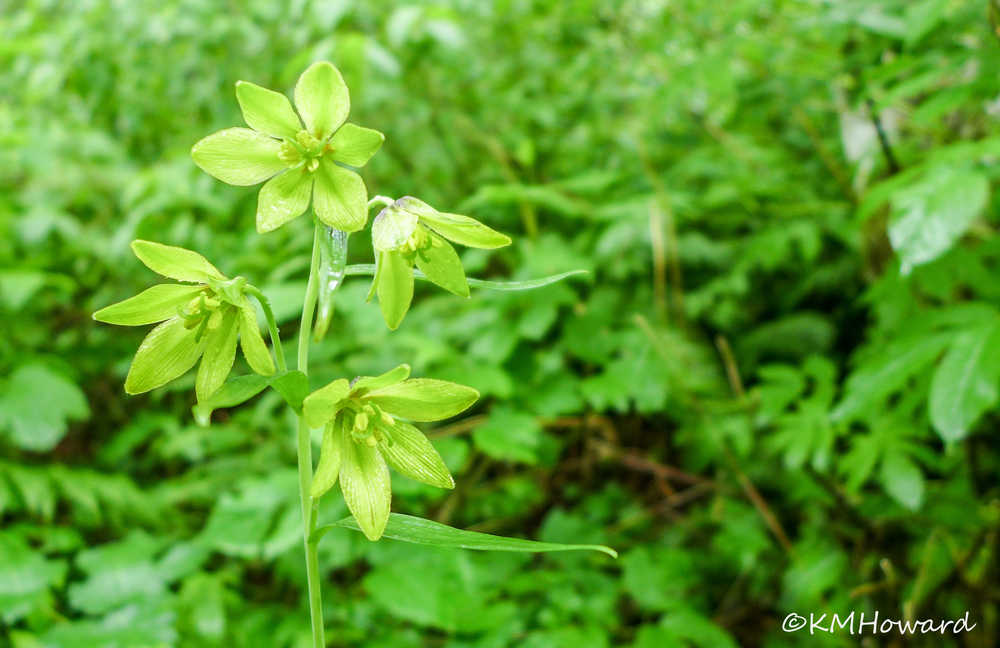Late May and early June found us wandering in several very fine places. Most of the time the weather was also fine!
On the trail to Granite Basin I heard eight kinds of songbirds in full voice. Three species of violets were on show, including the dark purple Alaska violet and my favorite yellow streamside violet. Three kinds of mountain heather were budding and blooming, not only the familiar yellow- and white-flowered species but the less common, pinkish-white Alaskan one. At least six other wildflowers bloomed at trailside.
Above the bridge that crosses Granite Creek, we saw a pair of harlequin ducks. The male was closely attentive to the female, indicating that she was still in egg-laying mode and he was defending his potential paternity. With any luck, a few weeks later, she will lead a flotilla of little ducks down the creek to the sea.
A Parks and Rec hike to Cowee Meadows in early June gave us the usual extraordinary flower show. Pink from roses and the last shooting stars, white from star flowers and cow parsnip, yellow from a sea of buttercups, purple from lupines and those wonderful irises. I was interested to see some scattered yellow-flowered chocolate lilies amid the usual brownish ones, and a pink lupine. Best of all, perhaps, was the great variation of hue offered by the irises, from pale lavender through all the shades of purple to a deep royal, and a stand of my favorite reddish-purple ones. What a visual treat!
Thinking about chocolate lilies reminds me to mention that they are pollinated by flies and maybe beetles. Their scent is described as being like rotten meat or feces, so it does not appeal to bees or humans. I don’t think I have ever seen a fly visiting these flowers, but local photographer Bob Armstrong has a video of a gang of blowflies crowding onto a cluster of flowers. The flies have yellow pollen dusted on their backs (and I have seen flies looking like that). I wonder if the flowers become particularly attractive only at certain times in their lives (like those of female-phase skunk cabbage). And are the rare yellow-flowered ones pollinated as well as the dark ones?
I have heard the cheery “Quick, three beers!” of olive-sided flycatchers ringing out from the edges of muskegs below Cropley Lake, on the Dan Moller trail, and on the Auke Nu trail. The reproductive rate is low, and their populations are declining significantly, for reasons undetermined. They feed mostly on flying insects, summer and winter, and spend the winter in Central and South America.
Much of the Auke Nu trail to the John Muir cabin is beset with several wide, deep, rooty mudholes that are getting bigger and bigger, as hikers try to go around them. Large canvas bags of gravel beside the trail suggest that there might be intentions of doing some trail repair some day. Many of the boards are rotten or broken or missing, and there are numerous hard-to-see popped-up nails that grab one’s cleats or boots, causing stumbles. This popular trail needs a lot of work.
A hike up the Bessie Creek trail begins (when not frozen) with a couple of miles of mostly mud and roots. The goal was a spread of nice meadows above the South Fork of Cowee Creek, where there can be good cross-country skiing (if we ever have good snow again). Once in the meadows, there was a leisurely lunch in the warm sun, while a greater yellowlegs scolded us loudly and ducks sailed in the old beaver pond.
Somehow we all, even those of us who had not intended to do so, decided to forge our way down to the main creek and come out near the highway bridge (where the road sign strangely calls it Kowee Creek, like the one on Douglas, even though all the maps spell the name with a C). This turned out to be a sorry choice for some of us, especially those who are rather far from being “spring chickens.”
Leaving the beautiful meadows, we thrashed for a very long time through seemingly endless tangles of eyeball-high blueberry bushes mixed with blowdowns. It felt like at least eight miles, although it was nowhere near that.
Of course, the springier chickens among us had to slow down to a pace we could all achieve to keep the group together.
Finally at the creek, out came the clippers to hack a way through devil’s club thickets until we found the fishermen’s trail. It was a hot, sunny day, and some hikers shared water with those whose supply ran out.
Eventually, all water bottles were dry, and we treated creek water to render it safely potable. We reached the highway at long last, so late that spouses and friends in town were getting worried; there was no cell phone contact in the area we had hiked.
But we all emerged in one piece, although some of the hikers were too tired take another step or even to talk. A one-time trek, for some of us.
• Mary F. Willson is a retired professor of ecology.

